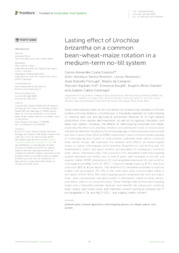Lasting effect of Urochloa brizantha on a common bean-wheat-maize rotation in a medium-term no-till system.
Lasting effect of Urochloa brizantha on a common bean-wheat-maize rotation in a medium-term no-till system.
Author(s): CRUSCIOL, C. A. C.; FERREIRA, J. H. S.; MOMESSO, L.; PORTUGAL, J. R.; CAMPOS, M. de; VOLF, M. R.; BORGHI, E.; SORATTO, R. P.; CALONEGO, J. C.
Summary: Grass intercropping under no-till is an option to increase crop residues on the soil surface and crop diversity. Urochloa spp. is frequently selected for intercropping to improve land use and agricultural production because of its high residue production, slow residue decomposition, as well as its vigorous, abundant, and deep root system. However, the effects of intercropping Urochloa and maize, especially the effects of Urochloa residues, on subsequent crops in rotation have not been established. To address this knowledge gap, a field experiment was carried out over 5 years (from 2014 to 2018) comprising 2 years of maize monocropping or intercropping and 3 years of crop rotation (common bean-wheat-common bean-wheat-maize). We evaluated the medium-term effects of monocropped maize or maize intercropped with Urochloa brizantha on soil fertility and the development, yields, and grain nutrient accumulation of subsequent common bean, wheat, and maize crops. The cultivation of U. brizantha in the intercropping system improved soil fertility over at least 4 years, with increases in soil pH; soil organic matter (SOM); phosphorus (P); exchangeable potassium (K), calcium (Ca), and magnesium (Mg); sulfur (S?SO42?); cation exchange capacity (CEC); and base saturation (BS) at all soil depths. The benefits of U. brizantha extended to root dry matter and distribution; 70?77% of the total roots were concentrated within a soil depth of 0.0?0.2?m. The intercropping system improved the root dry matter mass, yield components, and grain yields of subsequent common bean, wheat, and maize crops in all cultivation years. These findings indicate that intercropping maize and U. brizantha provides medium-term benefits for subsequent common bean, wheat, and maize crops, and improves nutrient cycling to increase soil P; exchangeable K, Ca, and Mg; S?SO42?; and organic matter content.
Publication year: 2023
Types of publication: Journal article
Unit: Embrapa Maize & Sorghum
Keywords: Agricultura tropical, Capim, Gramínea, Plantio Direto, Sistema Radicular
Observation
Some of Embrapa's publications are published as ePub files. To read them, use or download one of the following free software options to your computer or mobile device. Android: Google Play Books; IOS: iBooks; Windows and Linux: Calibre.
Access other publications
Access the Agricultural Research Database (BDPA) to consult Embrapa's full library collection and records.
Visit Embrapa Bookstore to purchase books and other publications sold by Embrapa.

